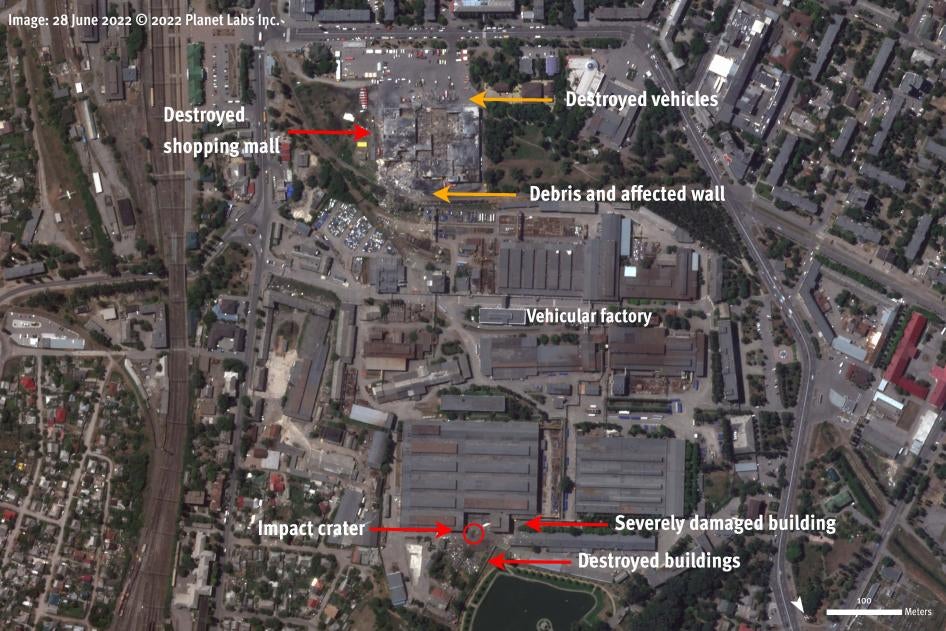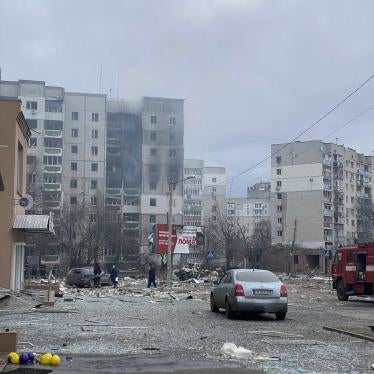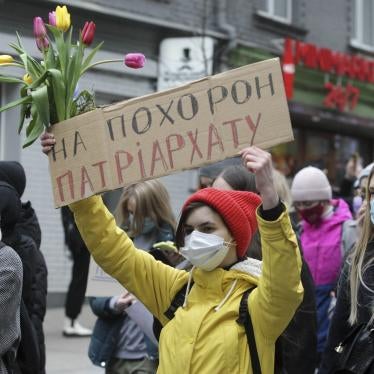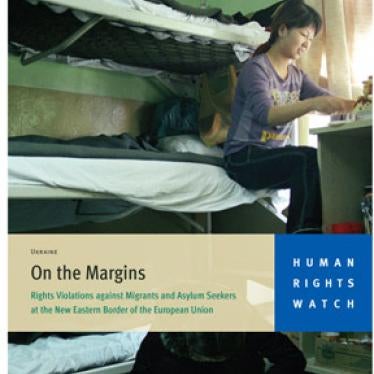(Poltava, June 30, 2022) – Russian forces launched a missile which struck a shopping center in Kremenchuk, central Ukraine, on June 27, 2022. The attack killed at least 18 civilians, according to local authorities, and wounded dozens of others, Human Rights Watch said today. On June 29, 36 people remained missing, as rescue efforts continued.
A Russian Defense Ministry official claimed that the shopping center had been closed at the time of the attack. He also claimed that the fire that damaged the shopping center had spread from the detonation of Western-supplied munitions caused by Russian forces’ strike in an industrial complex adjacent to the shopping center. Both claims are demonstrably false.
“The Russian missile that directly hit an open and busy civilian shopping center on June 27 caused devastating loss of civilian life,” said Yulia Gorbunova, senior Ukraine researcher at Human Rights Watch. “The incident should be investigated as a potential war crime, and if the Russian authorities don’t, the International Criminal Court and other investigative bodies should.”
The missile hit the shopping center around 4 p.m., destroying it and damaging several vehicles in its parking area. A second missile, minutes later, hit the north side of the Kremenchuk Road Vehicle Factory, a large industrial complex whose boundaries are less than 40 meters behind the shopping center, separated by a cement-block wall. The second strike hit 450 meters north of the first, leaving a crater approximately 16 meters wide and 5 meters deep. Four CCTV cameras recording different angles over a nearby park, captured the impact of the second missile. The CCTV time stamps show the second missile struck at 3:59 p.m. In one CCTV video, the smoke plume from the shopping center strike is visible. A Russian Defense Ministry official claimed that Ukrainian authorities stored weapons from the United States and European countries in the industrial complex. Ukraine’s interior minister said there were no military targets within five kilometers of the shopping center.
Based on site investigations on June 28 and 29, Human Rights Watch could not identify any evidence to indicate the industrial complex was storing munitions.
Contrary to Russian claims, although some of the shops closed after February 24, the shopping center remained open, witnesses, staff and shoppers said. Human Rights Watch spoke with 15 people, including people hospitalized with injuries, doctors, shop staff, other witnesses, and local officials.
Four people separately said that around 4 p.m., they heard two explosions minutes apart. Elena Guseva, 55, who works at a grocery kiosk opposite the shopping center, said she heard the air raid siren around 4 p.m., “prayed for it to be a false alarm”, went outside, and then heard a very loud explosion: “I screamed and jumped. I felt sudden pain in my chest and stomach. And saw huge black smoke over the shopping mall.”
Footage, recorded from a CCTV camera overlooking the industrial complex behind the shopping center, captured the moment the first missile hit the shopping center. The footage’s timestamp displays 3:51:54 p.m. An adviser to Ukrainian President Volodymyr Zelenskyy publicly shared the footage, whose exact location was first geolocated by the investigative journalism group Bellingcat and verified by Human Rights Watch by matching landmarks in the video with satellite imagery.
Human Rights Watch cannot at this time verify or disprove whether the industrial site was ever used for military purposes. However, Human Rights Watch observed its perimeter, and factory management granted researchers access to the complex. The factory’s deputy director, Viktor Shybko, said that the factory did not house any military vehicles, equipment, or personnel and only produced machinery for concrete and asphalt production.
Researchers were allowed unhindered access to the facility, including multiple warehouses, where they saw large, stationary machinery and old metal parts, some covered in dust. They found no evidence of military vehicles, weapons, or munitions. Since Russia’s February invasion, the factory operated only part time due to disrupted supply lines. On June 27, the workday ended at 3:30 p.m., and about 50 personnel remained when the missile hit. The site’s security staff is not militarized and are equipped only with radio and flashlights.
Kremenchuk’s deputy mayor, Olha Usanova, and Oksana Korlyakova, head of the intensive care clinic, Kremenchutskaya, said that only 5 of the 18 killed had been identified because the other bodies were so badly burned as to make visual identification impossible. After the attack, 57 people sought medical assistance at the clinic, 25 of whom – 15 men and 10 women – required hospitalization. One of them died shortly after arrival and five were in grave condition on June 28.
The officials said that most people hospitalized had traumatic brain injuries and other injuries caused by primary and secondary blast fragmentation. Medics sent one person with severe burn injuries to a specialized hospital.
A man hospitalized with head trauma and other injuries said he had been in the shopping center, lost consciousness, and woke up under a concrete slab. He said that he heard his wife, 43, screaming nearby. She was also trapped under concrete debris with her arm broken in three places: “As we were stumbling out [of the mall], she had to hold her arm with her other arm, and we could see the bone protruding under the skin.”
Mykolay, 39, who worked for 10 years as a consultant at an electronic store in the center, was also hospitalized. He said he heard an explosion followed by a “deafening crushing noise.” He remembered only being led outside by his colleagues, some of them injured and bleeding: “A part of the wall was completely gone, and we just walked through the opening to get outside.”
Petro, 41, an employee with another electronics store, had been sitting outside the center with a co-worker, Oleksandr, waiting for the air raid siren to end: “I saw a yellow flash in front of my eyes, and a wave threw me several meters, hitting wooden pallets before losing consciousness.” When Petro regained consciousness, he realized he had multiple cuts and blood gushing from his right arm. He was hospitalized with a concussion and multiple bruises on his back and head. His hand was visibly swollen and his back covered in bruises. His co-worker was hospitalized with leg fractures.
An IT expert who was a kilometer from the shopping center when the strike hit went to the center when he heard the explosion. He saw numerous emergency vehicles, and people being carried out with blood on their arms and head. He said there was a lot of smoke and the smell of burning plastic was so overpowering that he could not breathe and had to leave after about 20 minutes.
Rescue workers continue to comb the site for survivors. Human Rights Watch spoke with a family who said they called the morgue and every hospital in the city looking for their daughter, an employee at the shopping center, to no avail.
Human Rights Watch analyzed satellite imagery collected before and after the attack. A low-resolution image taken on June 27 at 11:18 a.m. shows no damage to the shopping center or factory. A high-resolution satellite image the following morning confirms that the attack hit at least two distinct areas, reducing the shopping center to rubble and severely affecting the surrounding areas. Several cars were destroyed and a section of the wall that surrounds the neighboring factory was damaged. Debris is spread in various directions.
The crater at the industrial complex was caused by the second strike. It hit the complex’s largest production warehouse and the greenhouse next to it. The satellite image shows the crater and damage to several surrounding buildings. The roof and northern façade of one of the buildings are severely damaged, and six buildings are destroyed.
The Ukrainian air force command identified the weapons used by Russia in the strikes as KH-22 (X-22 in Cyrilic) cruise missiles, fired from Russian aircraft. At the shopping center site, Ukrainian authorities presented remnants they said had been recovered from the strike. Human Rights Watch has not independently verified the weapons used in either strike. The impact crater in the factory and the blast damage to the shopping center are consistent with the detonation of warheads weighing nearly 1,000 kilograms with large high-explosive payloads.
If Russian forces were targeting the industrial complex, they had to or should have been aware of the large presence of civilians adjacent to their intended target. They had an obligation to distinguish those civilians and the civilian shopping center from any potential military objective, and to take all feasible precautions to minimize incidental loss of civilian life, injury to civilians and damage to civilian objects.
This includes not conducting a strike where the foreseeable risk of civilian casualties and harm to civilian objects clearly exceeds any concrete military advantage anticipated. Intentionally launching an attack where the loss of life or injury to civilians and damage to civilian objects would be clearly excessive in relation to the concrete and direct overall military advantage anticipated is a war crime.
The use of explosive weapons with wide-area effects in populated areas heightens concerns of unlawful, indiscriminate, and disproportionate attacks. These weapons can have a large destructive radius, are inherently inaccurate, or deliver multiple munitions simultaneously. This includes munitions with large, high-explosive warheads, as used in the June 27 attack. The use of these weapons should be avoided in populated areas.
“The civilians in Kremenchuk who suffered such intense loss from the June 27 strike deserve justice,” Gorbunova said. “There needs to be a thorough investigation, and those responsible should be held to account.”








